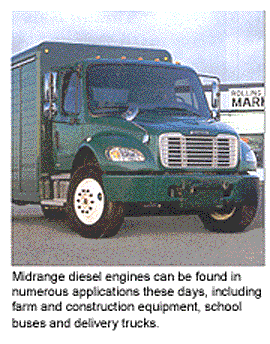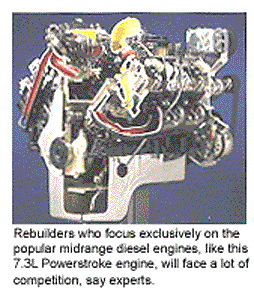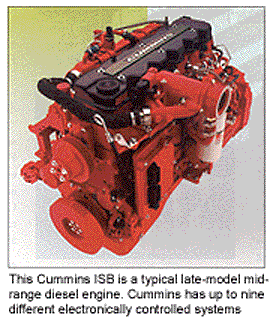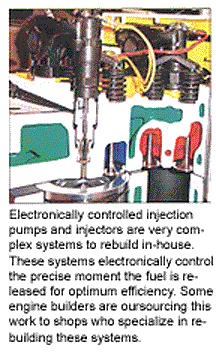The diesel engine market is a very complex one, but it can be broken down into three basic categories: light-, medium- and heavy-duty. These categories could then be broken down further into on-highway, off-highway and agricultural.
In 2004 roughly 1.5 million new diesel engines were produced in North America, a whopping 79.6 percent of which were for on-highway use. But while it’s interesting to see where the new engines are going, most engine builders don’t care where the old ones are coming from, as long as it comes through their door. Still, a closer look at the midrange diesel market should help identify where profits lie.

Midrange diesel engines are found in applications classified as light- to medium-duty with horsepower ratings in the neighborhood of 100-300 hp. This market can include everything from the 6.6L Duramax and Cummins B-series engines to smaller Class 6 and 7 engines. For remanufacturers, the midrange diesel market is very competitive, dominated by larger PERs and OEMs.
Applications
The sheer number of midrange diesel engine applications is astonishing. Everything from ambulances and delivery trucks to farm and construction equipment utilize one of these diesel engines, and it looks like in the future there will be even more applications. In 2005 the number of diesel engines is expected to climb, and much of that growth is expected to be in the midrange market.
Diesel engines offer many advantages over gasoline engines including more torque, increased fuel mileage and better durability. Many businesses purchase fleet vehicles with diesel engines for the long term cost savings.
“There are a lot more vehicles in the midrange market than there were 15 years ago,” says Scott Nichols, Strickland’s Diesel Service, Winston-Salem, NC. “Everywhere you look, you see one of those smaller Mitsubishi or Isuzu trucks running around. Many fleets use them for delivery vehicles. The engines are fitted into a wide variety of applications, so it’s a pretty large market.”
The applications you service will depend largely on your location, say experts. If you are close to an airport, for instance, you may find lucrative opportunities because many support vehicles are diesel powered.
There are many similarities between rebuilding gasoline engines and midrange diesel engines. Many custom engine rebuilders (CER) have most of the equipment needed to do the machine work on one of these engines. “I don’t think there’s much difference in rebuilding a midrange diesel engine from any other diesel engine,” explains Nichols. “However, some diesels, like the Isuzu, have a chrome liner, which makes it much more difficult for the rings to seat properly.”
The SB Chevy Factor
For the smaller custom engine rebuilder (CER) the midrange diesel market can be just as competitive as the production gasoline engine market. The biggest competitors CERs face may no longer be the PER – it is the OEMs. Navistar, Cummins, Caterpillar, Ford, International and others offer remanufactured engines and even some large PERs say that the smaller automotive-type diesel engines like the 7.3L Ford, 6.6L Duramax and Cummins B-series and others are very price sensitive because they are being remanufactured in high volume.
For the typical automotive machine shop, working on a midrange diesel engine will not be a big leap from gasoline engines. However, there are some differences that need to be recognized before you dive into this market. For the most part, standard automotive machine tools are appropriate for these engines, but you will need a few specialty tools.

This is especially true for the newer engines. Many of them are quite complicated compared to the older mechanical engines. They often require dyno time to properly tune the engine and time the injector pumps, and a rebuilder may need to tune the engine with the engine control unit (ECU) in many cases.
There are other differences as well.
“The OEs are changing the older engines a little. For example, some of the seals have been changed, so you will need a new seal installer tool,” explains Nichols.
Rebuilding diesel engines requires precision machining – this is absolutely critical. For instance, if you mill too much off a cylinder head and raise the compression ratio, you will also affect the injection timing. You will have to be concerned with injector protrusion, valve recession and protrusion and injector sleeves, so everything on a diesel engine has to be set exactly right or you will have a comeback.
Another difference you will find when working with diesels is that, despite their high mileage characteristics, when they do finally wear out, they are completely worn out. So you will have to rebuild every component in the engine as well as many of its accessories such as the turbo (if applicable) and fuel injection pump.
“If a shop does not rebuild ancillary components such as injector pumps and turbos, they will have a hard time making a profit,” according to Peter Burrows, Motive Parts, Inc., Port Washington, NY. “The market is extremely competitive even down to individual components like cylinder heads.”
Mike Schaefer of Southern Illinois Crankshaft offers a similar assessment. “When we rebuild a midrange engine it is more likely to be from a smaller piece of excavating equipment. We stay out of the light-duty market for the most part.”

According to Schaefer it’s not only possible to make a profit on an obscure midrange diesel engine but it’s more probable that you will. “The Hino midrange engine, for example, is obscure enough that most shops won’t want to touch it unless they’re a dealer,” explains Schaefer. “Personally, I would rather work on something odd than the 7.3L Powerstroke engine or other ‘popular’ engines. Some of them have become as competitive as the small block Chevy. You’ve got a better chance to make money on an engine that is not as much in demand.”
Cores and Parts Availability
Still, despite their attractive profit potential, it can be a challenge to find aftermarket parts for older or less popular engines. Rebuilders will have to rely on the OEM for some parts, even for some of the more recognizable midrange engines. “On some of the Japanese engines (such as Mitsubishi and Isuzu) and other import engines it can be difficult to track down the parts you need,” says Nichols. We’ve had trouble finding all of the necessary parts. There are some popular midrange diesel parts in the aftermarket, but a lot of the time you have to go to the dealer. And that makes it difficult to be competitive.”
Even the newer engines can be difficult to get parts for as well. The new V-Mack and E-Tech engines are often only lasting 100,000 miles before spitting out camshafts, according to Motive’s Burrows. “Often, when the cam seizes, if the operator neglects the problem, it eventually throws a rod. Subsequently, we have a heck of a time getting good blocks for these engines because so many of them are windowed.”
There may be core availability issues with a few of the older midrange engines. According to one rebuilder, manufacturers and salvage yards are gobbling up cores as quickly as they can. Some theorize that manufacturers want to pull older cores off the market in order to sell more of the new-style EPA-approved engines. Salvage yards, on the other hand, have quite the opposite reason: they know that the older cores will be a valuable commodity and therefore want to stock their shelves with as many as possible so they can sell them back to rebuilders for a premium.
“I know, for example, that John Deere is grabbing up cores,” says Nichols, “and if you buy a new engine from them you will have to return your old core or be subject to a hefty core charge. The manufacturers appear to be trying to take the older-style engines out of the market. And as far as the EPA is concerned, they would like to be rid of the old cores so everyone has to buy a new, low-emission engine.”
EPA Involvement
In October 2002 EPA required all on-highway diesel engines to meet more stringent emissions requirements. Manufacturers had to go back to the drawing board and come up with completely new engine designs. Not all midrange engines are currently affected by the new EPA regulations (such as those for off-highway use), but regulations are likely on the way. In 2007 when low sulphur fuel is available, there will likely be another wave of new engine designs from the manufacturers.
According to some engine builders, more pre-EPA engines are being rebuilt now than ever. Because these pre-EPA midrange engines are much less complicated than their post-EPA electronic injection counterparts, they may offer the most profit potential to CERs looking for a niche market to get into. Parts for older engines are available from multiple aftermarket suppliers, and the dealers still stock many parts for these engines as well. And though EPA certified emission systems are not currently required, there may even be opportunities for rebuilders to
“I think the parts issues on the later model engines will become a real challenge for the aftermarket,” says Motive’s Burrows. “The manufacturers are making so many product changes because they’ve had problems. They think that by changing things they are fixing the problem. No aftermarket supplier is going to want to tool up to make parts for each revised engine because there are so many changes.”
Changing Market
Without question, the EPA standards for new diesel engines have had a significant impact on the market. But, exactly how it affects engine builders is not yet known. According to several engine builders, they are seeing more work on older leading some to believe that many companies cannot yet afford to upgrade to the newer EPA engines.
Another rebuilder noted that while it’s hard to compete with some of the bigger remanufacturers on the more popular light-duty diesel engines, if an engine was out of a more valuable application such as farm or construction equipment, there was more incentive for the customer to go through with a rebuild rather than replace the equipment.
In the heavy-duty market there have been concerns over newer engines not being as durable, but in the midrange market that doesn’t appear to be a problem. For rebuilders in the midrange market, the challenges may be that newer electronic engines last too long.
“One of the things that will have a significant impact on this industry is longevity. The older 6.9L, 6.5L, 6.2L and even 7.3L engines went about 200,000 miles before needing rebuilt. Now, late-model electronic engines are going 400,000 miles,” says Zach Bawel of Jasper Engines and Transmission. “The market is very similar to what happened when gasoline engines went electronic. So the need for rebuilding or remanufacturing is not as strong as it once was 15-20 years ago because engines today last much longer.”
Electronic Engines
Much in the way that electronic fuel injection affected the production gasoline engine market it has had an impact on late-model midrange diesel engines. Electronically controlled pumps and high-pressure common rail systems have replaced mechanical injector pumps, offering variable injection timing to deliver the right amount of fuel at exactly the right moment.
retrofit older engines with them.

The point that fuel is injected on a diesel engine must be timed precisely; otherwise the engine will clatter and emit excessive smoke in the exhaust. On older diesel engines, a high-pressure mechanical pump is timed similar to a distributor by rotating its index position with respect to the camshaft.
New style diesel engines still have high-pressure pumps, but injection timing is now electronically controlled through the vehicle’s ECU. A crankshaft or camshaft position sensor and injection control pressure sensor are used to calculate injection timing, which is crucial to a diesel engine’s performance.
Several engine builders said they do not rebuild electronic pumps in-house because equipment to test injector pumps is very expensive. And unless you specialize in rebuilding pumps it may not be worth the added expense. So some engine builders prefer to outsource this end of the job to a shop that specializes in rebuilding electronic pumps.
“You have to have all of the computerized equipment to set up these electronic engines and test them properly,” says Zach Bawel, Jasper Engines. “I’d say the electronic side of the diesel market has made it much more complicated to work on these engines. Years ago, we used to do our own injector pumps. Now we outsource all of the electronic injection work to someone else who specializes in it.”
For some engine builders, though, the warranty exposure may be too high to feel comfortable outsourcing injector pump work, building just the long block and sending it out the door.
“We rebuild everything from the pumps to the injectors,” says Motive’s Burrows. “If you let an installer put a pump on he doesn’t necessarily have the qualifications or the special tooling to time it properly, especially with electronic engines. For example, you can’t time the 6.5L GM until you put it in the vehicle to match the computer. We feel it’s important to do that ourselves – and of course, we charge extra for this service.”
There is still strong demand for older midrange diesel engines at the present time, and some rebuilders may not yet have even seen some of the newer engines. But electronically controlled diesel engines loom on the horizon as either an opportunity to get into the market and be a specialist or to get out and find another niche. As one rebuilder said: “You’re either in it with all the market’s pitfalls or you’re out of it. There’s no in between.”













